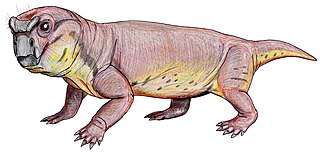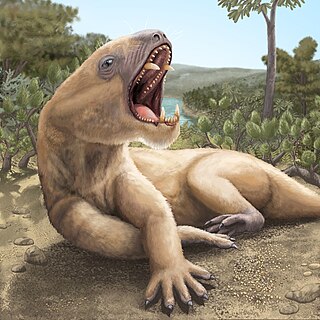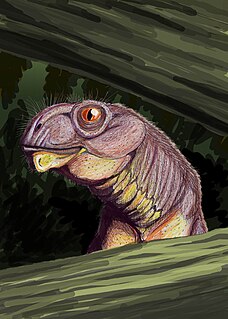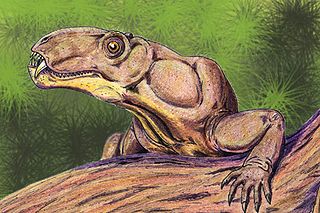 W
WAkidnognathidae is an extinct family of therocephalian therapsids from the Late Permian and Early Triassic of South Africa and Russia. The family includes many large-bodied therocephalians that were probably carnivorous, including Moschorhinus and Olivierosuchus. One akidnognathid, Euchambersia, may even have been venomous. Akidnognathids have robust skulls with a pair of large caniniform teeth in their upper jaws. The family is morphologically intermediate between the more basal therocephalian group Scylacosauridae and the more derived group Baurioidea.
 W
WChainosauria is a large clade of anomodont therapsids. It includes dicynodonts, dromasaurians and the basal taxa Patranomodon.
 W
WDicynodontoidea is an infraorder of dicynodont therapsids that includes the famous dicynodont Dicynodon, Lystrosaurus and the Triassic Kannemeyeriiformes, as well as numerous other closely related species. The name was coined by American paleontologist Everett C. Olson in 1941 as an infraorder, despite using the typical "-oidea" suffix of superfamilies, and was later redefined under a phylogenetic context in 2009 by paleontologist Christian F. Kammerer.
 W
WGalepus is an extinct genus of anomodont therapsids.
 W
WGeikia is an extinct genus of dicynodont therapsids from the late Permian. The abundance and diversity of dicynodonts during this period, combined with incomplete or inadequately prepared specimens, have led to challenges in determining relationships within this taxon. Only two species, Geikia locusticeps and Geikia elginensis have been assigned to this genus. While this is the currently accepted classification, fossil record limitations have led to repeated debate on the genus assignments of these species.
 W
WGeikiidae is a family of Late Permian dicynodonts. Fossils are known from Scotland, South Africa, and Tanzania. The family was first named by Franz Nopcsa in 1923, although Friedrich von Huene's 1948 description of the family brought it into common usage. Von Huene established Geikiidae as a monotypic family for Geikia, then known from Scotland. He distinguished Geikia from all other dicynodonts because it lacked a preparietal bone. The outlines on the bones of the skull roof could not be seen however, meaning that this characteristic was uncertain in geikiids. Geikiids were originally classified as close relatives of Dicynodon and Lystrosaurus, but the characters that linked these dicynodonts are also seen in many other forms. It is more likely that features seen in Dicynodon and Lystrosaurus, such as widely separated eye sockets, evolved in parallel in geikiids.
 W
WHaptodus is an extinct genus of basal sphenacodont, member of the clade that includes therapsids and hence, mammals. It was at least 1.5 metres (5 ft) in length. It lived in present-day France during the Early Permian. It was a medium-sized predator, feeding on insects and small vertebrates.
 W
WLycosuchidae is an extinct family of therocephalian therapsids from the Middle Permian Beaufort Group of South Africa. It currently contains two monotypic genera, Lycosuchus, represented by L. vanderrieti, which was named by paleontologist Robert Broom in 1903, and Simorhinella, represented by S. baini, which was named by Broom in 1915. Both species are characterized by their large body sizes and short, deep snouts. Two sets of enlarged canine teeth were once regarded as a defining feature of lycosuchids, but recent studies have proposed that the front-most pair are replacements for the ones behind them, which would have eventually fallen out as individuals aged. Lycosuchids are the earliest known therocephalians and are also thought to be the most basal.
 W
WLystrosauridae is a family of dicynodont therapsids from the Permian and Triassic time periods. It includes two genera, Lystrosaurus and Kwazulusaurus. Kwazulusaurus includes a single species, K. shakai, from the Late Permian of South Africa and Lystrosaurus includes many species from the Late Permian and Early Triassic of South Africa, India, and Antarctica.
 W
WMesenosaurus is an extinct genus of non-mammalian synapsids. It belongs to the family Varanopseidae. This peylcosaurian family has the longest fossil record and the widest geographical distribution.
 W
WMoschowhaitsia is an extinct genus of therocephalian theriodonts. It was among the larger carnivores in the faunal assemblages it occurred in.
 W
WNanictidopidae is an extinct family of therocephalian therapsids from the Late Permian. Two genera are currently included in the family, Nanictidops from South Africa and Purlovia from Russia. Nanictidopids have short skulls and were probably herbivorous.
 W
WOtsheridae is an extinct family of small herbivorous anomodont therapsids that are known from the Permian of Russia.
 W
WPhthinosuchia is an extinct group of therapsids including two poorly known species, Phthinosuchus discors and Phthinosaurus borrisiaki, from the Middle Permian of Russia. Phthinthosuchus is known a partial crushed skull and Phthinosaurus is known from an isolated lower jaw. The two species have traditionally been grouped together based on their shared primitive characteristics, but more recent studies have proposed that they are more distantly related. Phthinosuchus is either a carnivorous gorgonopsian relative or an anteosaurian dinocephalian while Phthinosaurus is either a herbivorous rhopalodont dinocephalian or a therocephalian.
 W
WPristerodontia is a group of dicynodont therapsids that includes cryptodontids, geikiids, lystrosaurids, kannemeyeriids, and other related forms. Pristerodontians were one of the few groups of dicynodonts to survive the Permian–Triassic extinction event, diversifying in the Triassic.
 W
WPylaecephalidae is a family of dicynodont therapsids that includes Diictodon, Robertia, and Prosictodon from the Permian of South Africa. Pylaecephalids were small burrowing dicynodonts with long tusks. The family was first named in 1934 and was redefined in 2009. Diictodontidae and Robertiidae are considered junior synonyms of Pylaecephalidae.
 W
WScylacosaurus is an extinct genus of therocephalian therapsids.
 W
WVenyukoviidae is an extinct family of small herbivorous anomodont therapsids that are known from the Permian of Russia.
 W
WVenyukovioidea is an infraorder of anomodont therapsids from the Permian of Russia. It includes the genera Otsheria, Venjukovia, Ulemica, and Suminia. Venyukovioidea and Dromasauria were traditionally considered the two main groups of basal anomodonts. Dromasauria was considered a Gondwanan group while Venyukovioidea was a Euramerican group. More recent studies consider Dromasauria to be paraphyletic. Venyukovioidea is thought to have arisen from basal anomodonts in Africa and underwent an evolutionary radiation in Russia.